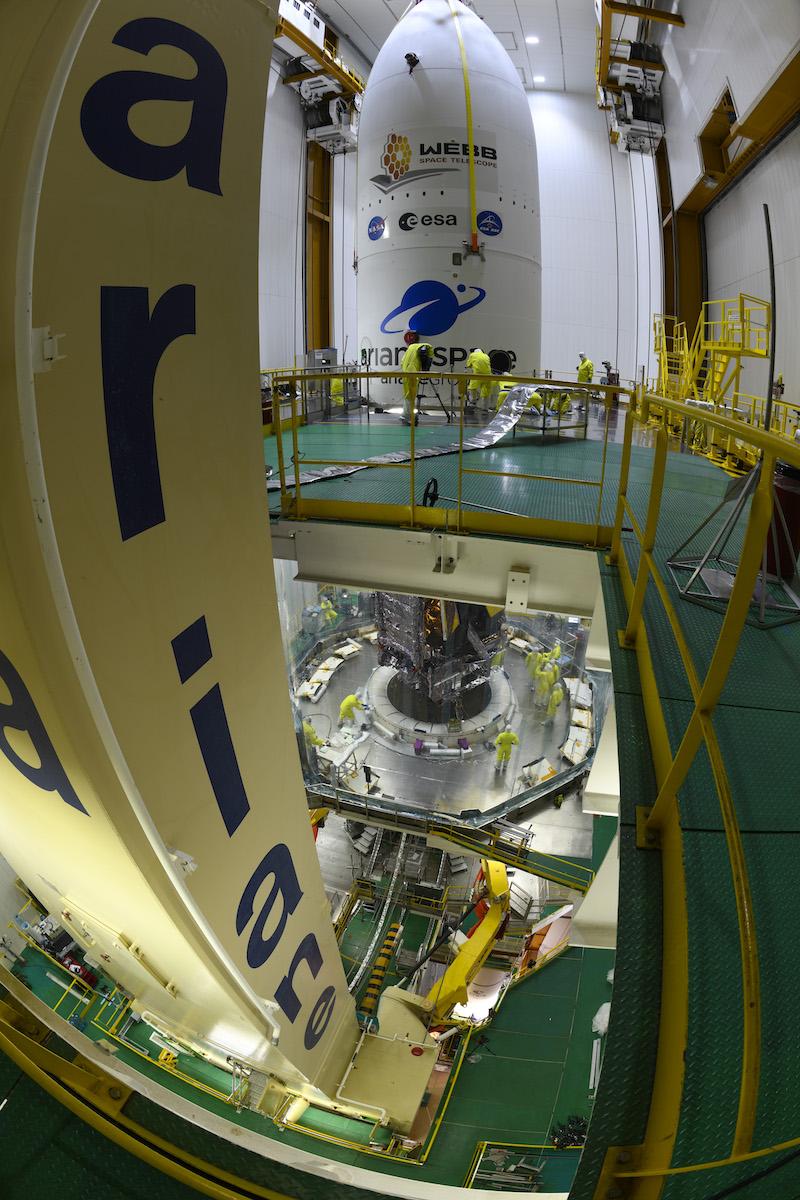
The James Webb Space Telescope has been closed up inside the nose cone of its Ariane 5 launcher in French Guiana, and officials confirmed Saturday the huge astronomical observatory is set for blastoff Dec. 24.
The 30-minute launch window opens at 7:20 a.m. EST (1220 GMT; 9:20 a.m. French Guiana time). The Ariane 5 rocket’s half-hour ascent will dispatch Webb, standing three stories tall on top of the launcher, on a trajectory toward an orbit around the L2 Lagrange point nearly a million miles (1.5 million kilometers) from Earth.
Webb, which cost $9.7 billion to design and build, is a successor to the 31-year-old Hubble Space Telescope. The encapsulation inside the Ariane 5 rocket’s payload shroud late Friday at the Guiana Space Center in South America marked the final time ground teams will see Webb with their own eyes.
A laser alignment system helped slowly guide the Swiss-made payload fairing, suspended under a crane, over the top of the Webb telescope inside the Ariane 5’s final assembly building in French Guiana. Webb is folded up origami-style to fit inside the fairing, made by RUAG Space and measuring some 17.7 feet (5.4 meters) in diameter.
Even with it folded up for launch, some parts have just 8 inches (20 centimeters) of clearance between the observatory and the inside wall of the Ariane 5 payload fairing.
The shroud was adapted for use on the Webb mission to meet stringent cleanliness requirements. Engineers also modified venting ports to help equalize pressure inside the fairing with the vacuum of space, so there’s no sudden puff or disturbance when the fairing jettisons from the rocket a few minutes after liftoff.
Officials were concerned a sudden depressurization might damage Webb’s five-layer sunshield, one of the most sensitive components on an observatory that’s full of them.
The sunshield will open up to the size of a tennis court about a week after launch to begin cooling the telescope and its instruments to cryogenic temperatures, cold enough to allow Webb’s infrared detectors to detect faint light from the oldest and most distant reaches of the universe.
The encapsulation late Friday came after a several days of troubleshooting to resolve a communications interface issue found after workers lifted Webb on top of the Ariane 5 rocket Dec. 11. The troubleshooting delayed Webb’s launch from Dec. 22 to Dec. 24.
With the problem behind them, teams will focus on a launch readiness review planned in French Guiana on Tuesday, followed by rollout of the Ariane 5 rocket to its launch pad Wednesday, setting up for the start of the countdown Thursday night and liftoff Friday morning.
Email the author.
Follow Stephen Clark on Twitter: @StephenClark1.
from Spaceflight Now https://ift.tt/3ebjz53
via World Space Info







0 comments:
Post a Comment